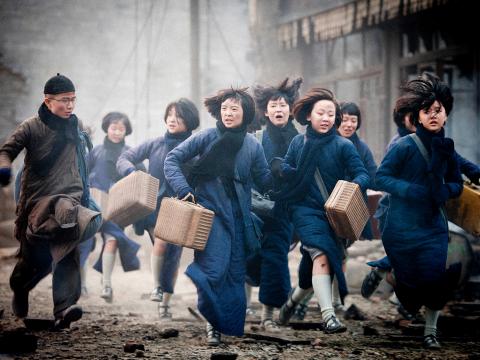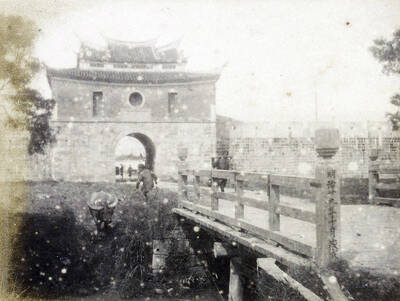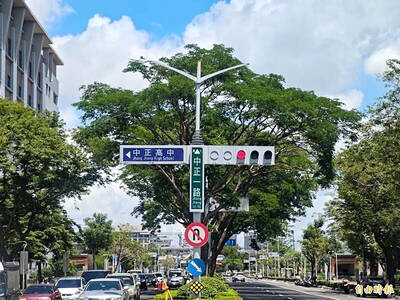Eventually, it seems, every senseless waste of life gets its own gauzy tear-jerker. That’s about the only way to justify The Flowers of War (金陵十三釵), in which veteran Chinese director Zhang Yimou (張藝謀) revisits the Nanjing Massacre of 1937 by making something resembling a backstage musical, with breaks for the occasional ghastly murder or rape.
There’s nothing that says the atrocity blockbuster has to be a disaster in its own right; films like Gone With the Wind and Gallipoli have their good points. But long before its 2 1/2 hours are up, The Flowers of War is sunk by the disproportion between the events being portrayed and Zhang’s distanced, strangely frivolous treatment of them — in essence, his refusal to take a point of view on one of the most gruesome chapters in Chinese history.
Flowers has received bountiful publicity for being expensive, state-approved and Oscar-submitted, buzz that got louder in December when the film’s British star, Christian Bale, was forcibly prevented from visiting a Chinese activist lawyer being held under house arrest.

Photo courtesy of BVI
But fears that Zhang would take a one-dimensional, patriotic approach to the Japanese invasion and occupation of Nanjing, while not entirely unfounded, are misplaced. Other recent Chinese films have displayed more sentimental nationalism, jingoism and demonization of the
Japanese enemy.
His real approach to the events of 1937 is to use them as a backdrop for the kind of deluxe, Hollywood-inspired melodrama that has made him an art-house favorite. In the process he fails to deliver on most of the elements — grandeur, historical sweep, genuine pathos — that would have made the film worthwhile.
Given the right story, as in Raise the Red Lantern (大紅燈籠高高掛組) or House of the Flying Daggers (十面埋伏), Zhang’s almost clinical attention to pretty surfaces and soap-opera mechanics can have entertaining results. In Flowers, though, you can feel him at war with his material, never settling on a tone or a compelling or even coherent narrative. (The screenplay is by Liu Heng (劉恆) and Geling Yan (嚴歌苓), based on a novel by Yan.)
Zhang’s distance from the larger story of the massacre is embodied in his decision to set most of the film within the compound of a fictional European church. The result is an artificial, back-lot atmosphere; the opening scenes, set in the streets, take place in an actual fog of war, with smoke (and at one point the dust from a large mound of flour) isolating the characters from the real world of Nanjing.
Bale plays John Miller, a disreputable American vagabond who happens to be a mortician; as the film begins he is making his way through the fighting toward the church, where he is to be paid to conduct a burial. Also on the move are two groups of a dozen or so young women, the flowers of the title. They are, as a matter of production design if not credible history, visually coded: convent students in severe blue jackets and prostitutes in seductive, rainbow-hued silken dresses.
All of these parties take refuge in the church, with Miller, who dons the robes of a dead priest, bridging the Manichaean divide between the suspicious students upstairs and the contemptuous, defensive prostitutes hiding in the basement. (They quickly transform their cellar into a seraglio; you can practically smell the perfume.) It’s a contrived, hothouse state of affairs, summed up in a scene Zhang likes so much that he repeats it: the laughing prostitutes sashaying across the churchyard in slow motion, oblivious to the impending tragedy.
There will be tragedy, of course, though when it comes it takes a weirdly oblique form. One group eventually performs what appears to be an ultimate sacrifice, full of sexual and social overtones, but this happens off-camera, if it happens at all. The coyness can be explained, perhaps, in terms of the film’s structure — the story is narrated by one of the students, and what we see may correspond to her selective, romanticized memories — but it cannot really be excused.
On-screen, meanwhile, the camera ventures into the outside world in occasional scenes that seem timed to goose the action and remind us that we’re watching a war movie. In one of Zhang’s few outright concessions to the notion of Chinese supremacism, a lone officer (Tong Dawei, 佟大為) draws a contingent of Japanese soldiers away from the church in an act of hyperbolic heroism. Later, in a surrender to gross sentimentality, two prostitutes leave the church on the sort of insane mercy mission that happens only in movies, with particularly disturbing consequences. Aside from that sequence Zhang is restrained in his depictions of Japanese brutality, which mostly take the form of threats and intimidation.
Bale, turning in a respectable if oddly chipper performance under the circumstances, has the unfortunate task of playing a character who doesn’t really add up. Miller’s conversion from opportunist to savior may be another stock element of this sort of movie, but the scene meant to showcase his transformation is rushed and ineffective. Having made an American the central figure in his film, Zhang reduces him to wrangling flocks of nubile women, like Cary Grant in a much more violent Father Goose.
The Flowers of War suffers greatly in comparison to several far superior, less hyped movies about the Nanjing Massacre, including the harrowing drama City of Life and Death (南京!南京!), directed by Lu Chuan (陸川), and the documentary Nanking, by Bill Guttentag and Dan Sturman. Those filmmakers came armed with points of view. Zhang, retreating into the mists of old movies, has declined to take the field.

June 9 to June 15 A photo of two men riding trendy high-wheel Penny-Farthing bicycles past a Qing Dynasty gate aptly captures the essence of Taipei in 1897 — a newly colonized city on the cusp of great change. The Japanese began making significant modifications to the cityscape in 1899, tearing down Qing-era structures, widening boulevards and installing Western-style infrastructure and buildings. The photographer, Minosuke Imamura, only spent a year in Taiwan as a cartographer for the governor-general’s office, but he left behind a treasure trove of 130 images showing life at the onset of Japanese rule, spanning July 1897 to

One of the most important gripes that Taiwanese have about the Democratic Progressive Party (DPP) is that it has failed to deliver concretely on higher wages, housing prices and other bread-and-butter issues. The parallel complaint is that the DPP cares only about glamor issues, such as removing markers of Chinese Nationalist Party (KMT) colonialism by renaming them, or what the KMT codes as “de-Sinification.” Once again, as a critical election looms, the DPP is presenting evidence for that charge. The KMT was quick to jump on the recent proposal of the Ministry of the Interior (MOI) to rename roads that symbolize

On the evening of June 1, Control Yuan Secretary-General Lee Chun-yi (李俊俋) apologized and resigned in disgrace. His crime was instructing his driver to use a Control Yuan vehicle to transport his dog to a pet grooming salon. The Control Yuan is the government branch that investigates, audits and impeaches government officials for, among other things, misuse of government funds, so his misuse of a government vehicle was highly inappropriate. If this story were told to anyone living in the golden era of swaggering gangsters, flashy nouveau riche businessmen, and corrupt “black gold” politics of the 1980s and 1990s, they would have laughed.

In an interview posted online by United Daily News (UDN) on May 26, current Chinese Nationalist Party (KMT) Chairman Eric Chu (朱立倫) was asked about Taichung Mayor Lu Shiow-yen (盧秀燕) replacing him as party chair. Though not yet officially running, by the customs of Taiwan politics, Lu has been signalling she is both running for party chair and to be the party’s 2028 presidential candidate. She told an international media outlet that she was considering a run. She also gave a speech in Keelung on national priorities and foreign affairs. For details, see the May 23 edition of this column,